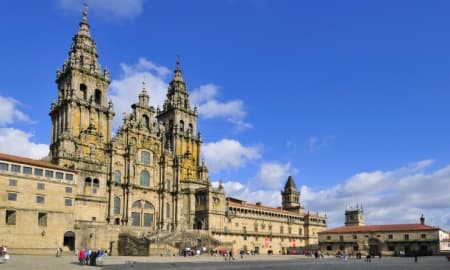
The Way of Saint James
The Way of St. James, which today is usually called the French Way of St. James, is one of the most important Christian pilgrimage routes in Europe and one of the busiest each year.
This route, whose origin dates back to the Middle Ages, aims to visit the tomb of the apostle St. James the Greater, located in the Cathedral of Santiago de Compostela in the Autonomous Community of Galicia.
The origins of the pilgrimage
The great popularity and appeal of this pilgrimage is due to the fact that, according to tradition, St. James the Greater was the first Christian apostle to become a martyr of the faith, and his corpse was transferred to the then-Roman province of Hispania, somewhere in Gallaecia, until it was discovered around the year 820 in a settlement abandoned by the Romans.After the discovery, the place became a sacred site with the construction of a monumental temple over his tomb. This was successively expanded and renovated over the centuries until it was transformed into the current cathedral.
This gave rise to authentic fervour among believers, creating a cult that quickly spread among Iberian Christians and beyond the borders to the rest of Christian Europe—so much so that Alfonso II established the Jacobean cult, creating around him a solid political and religious union of enormous importance, especially during the reconquest.
The birth of the Way of St. James
This fervour and devotion translated into annual pilgrimages in which the faithful crossed significant distances, many of them difficult and insurmountable due to their topography or because they were in inhospitable terrain. That is why it became necessary to create a direct route to the temple of St. James and, thus, be able to pay respects to his remains.
In addition to building the Way of St. James, the authorities were obliged to create an entire infrastructure and logistics that offered accommodation, services and assistance to the pilgrims, as well as a series of legal regulations that protected the pilgrimage. This made the route a true sanctuary for passers-by.
The first confirmed testimony of the existence of this series of infrastructures dates back to the year 1120, when inns and hospices for pilgrims were already in operation along the route.
The first confirmed testimony of the existence of this series of infrastructures dates back to the year 1120, when inns and hospices for pilgrims were already in operation along the route.
The second crisis, and undoubtedly the most serious one, occurred in the 19th century, when the French Revolution triggered a great anti-clerical and secularization movement. The Church separated from the State, which later had repercussions in Spain and resulted in the loss of a great part of the infrastructure due to severe confiscations, lasting well into the 20th century.
The resurrection of the Way of St. James as a tourist mainstay
Starting in the 1950s, fervour was reborn among the population, especially due to the push of the Franco regime. This translated into an increase in the number of pilgrims, not only as a matter of faith but also underpinned as a mainstay of what has come to be called the liturgical tourist.
This tourist mainstay was supported by a new infrastructure—no longer hospices or simple inns but, rather, modern hotels, restaurants and tourist stops where the faithful could enjoy good food and modern comforts.
This attracted not only the faithful but also lovers of nature, athletes, hikers, etc.
Thanks to this new policy to attract tourism, starting in the 1990s, the number of pilgrims multiplied significantly, reaching almost 250,000 people by 2019.
This attracted not only the faithful but also lovers of nature, athletes, hikers, etc.
Thanks to this new policy to attract tourism, starting in the 1990s, the number of pilgrims multiplied significantly, reaching almost 250,000 people by 2019.
The long route of the Way of St. James
There are several itineraries to reach the Way of St. James. One of them is to come from the western Pyrenees and reach Santiago de Compostela, but there are other, very popular routes such as the one used by the original pilgrims, which starts in Oviedo and continues through Lugo and then to the Locus Sancti Iacobi.
Currently, the Way of St. James covers a series of towns such as Pamplona, León and Bordeaux, among others, so that pilgrims can cross populated areas with great tourist and heritage attractions. This creates a network that offers all the necessary facilities to pilgrims and at the same time works as a magnificent tourist lever.
With the passage of time, other routes disappeared or merged into main roads. Some of these routes arose from France in Paris and Le Puy. Others were even farther away, from Germany and Italy.
With the passage of time, other routes disappeared or merged into main roads. Some of these routes arose from France in Paris and Le Puy. Others were even farther away, from Germany and Italy.







